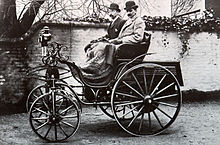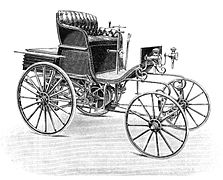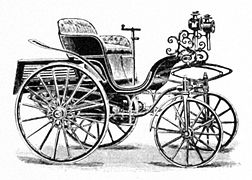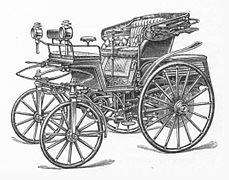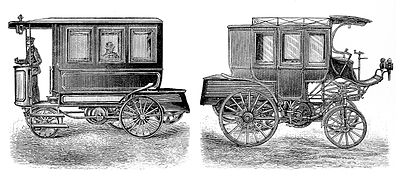Anhalt motor vehicle factory
| Anhalt motor vehicle factory | |
|---|---|
| legal form | |
| founding | 1895 |
| resolution | 1898 |
| Seat | Dessau , Germany |
| management | Friedrich Lutzmann |
| Number of employees | about 20 |
| Branch | Automobile manufacturer |
The Anhaltische Motorwagenfabrik was a German automobile manufacturer.
Company history
Friedrich Lutzmann manufactured his first vehicle in 1893 and founded the company in Dessau in 1895 to produce automobiles . The brand name was Lutzmann . Production in Dessau ended in 1898. Opel from Rüsselsheim took over the machines and hired Friedrich Lutzmann as director for motor vehicle production.
vehicles
In 1893 a tricycle with a rear single wheel was created that was also steered. A single - cylinder four-stroke engine with 1.5 hp drove the front axle. The driver sat in the back on a saddle. In front was a bench for one passenger. The vehicle was 200 cm long and 115 cm wide. The curb weight was given as 150 kg.
Probably in May 1894 (the exact date is not known), a good year after Lutzmann's first encounter with the Benz motor car, the company's first roadworthy vehicle left the factory hall. Apart from the usual general carriage shape and the - also (still) usual - power transmission via belt drives and chains, both vehicles differ from a technical point of view. The Lutzmann not only has a different type of steering (Lutzmann's own invention, patent no. 79039) and a front suspension based on the bicycle. The design of the engine also differed significantly from the Benz.
In addition to the gold decorations on black lacquer and red rims, the wrought-iron ornaments that served as lamp holders were particularly striking. The elegant appearance, also in comparison to the rather clumsy carriages of the competition, made it clear that Lutzmann was a trained art fitter.
In the same year, the manufacturer FA Schreiber from Köthen bought a Lutzmann for ℳ 4,000 . Another Lutzmann motor vehicle was even exported to Aden , Arabia , as the “Bernburger Wochenblatt” reported in August 1895. Over the years Lutzmann automobiles have also been exported to Great Britain, the Netherlands and numerous other countries.
Lutzmann employed only around 20 workers in his Dessau factory, significantly fewer than, say, the competitors Daimler and Benz. The company itself did not operate under the name Anhaltische Motorwagenfabrik until December 1898 .
Design features
Compared to the competition from Benz and Daimler, Lutzmann's motor vehicle had a major advantage: Lutzmann used ball bearings for axles and drive shafts as well as the steering column, which significantly reduced the car's frictional resistance. With rather modest engine outputs of 3 to 4 HP, this measure resulted in a noticeable increase in the top speed. Lutzmann manufactured the ball bearings in his own workshop, as the versions available for bicycles were not sufficiently dimensioned.
A particular focus of the design was on minimizing weight.
In 1895, Lutzmann also patented a belt drive (Pat. 87231/93843/109473) that managed with just one lever and was later used in all Lutzmann motorized carriages. This led to a significant simplification of operation. Reverse gear was also available for an additional charge. In addition, the vehicles had a patented freewheel device for the rear wheels, which served the same purpose as the differential later on in cardan-driven vehicles . As with the Benz motor cars of that time, belt drives managed without a clutch.
Probably the most significant improvement, however, was a cooling water tank cooled by the wind from the wind (utility model protection no. 82841), which significantly reduced the cooling water requirement of Lutzmann automobiles, which was also a great advantage over the competition. A Benz car from this time had a gasoline consumption of 20 and a cooling water consumption of 150 (!) Liters per 100 km, a major weak point of the design with simple evaporative cooling .
In the course of production, improvements were introduced again and again.
engine
The engine had an "automatic" intake valve that was controlled by negative pressure. The exhaust valve, on the other hand, was controlled by a cam on the crankshaft. Both valves have been combined in one component for the purpose of simplification (Pat. No. 93233).
All engines were single-cylinder with an engine capacity from 1500 to 3500 cm 3 . The power was approximately 1.5 to 9 PS at 400-500 min -1 . They all already had advanced electrical ignition using a Rühmkorff spark inductor . The motor housings were made from high-quality forged steel, which ensured above-average quality and durability.
The later models with a surface carburetor integrated into the petrol tank to save space aroused some interest from the trade press and interested laypeople, who wrongly described the Lutzmann engine as "carburettor-free".
Model versions
Overall, the Lutzmann motor vehicle was offered in at least 14 different versions, most of which were nicknamed the "arrow". At least one of each of these model variants was actually built.
The smallest model was the relatively light and simple arrow A or its further development, the arrow 0 , which was also known as the "light hunting car". The two-seater Pfeil 1 and the four-seater Pfeil 2 were one size larger and , in contrast to the smaller models, had axle fork steering . As arrow 1 B a particularly elegant embodiment of the two-seater model with wire wheels has been designated in place of the heavy wooden spoke wheels. Because of its lower weight, this vehicle reached a top speed of 30 km / h. The arrow 3 was a six-seater also equipped with the Lutzmann-typical axle fork steering.
More exotic model variants were the Arrow 4 , a stagecoach-like eight-seater, the Arrow 5 , which was reminiscent of a tram of that time and could carry 12 passengers, and the Arrow 6 delivery van . In later models of this type, the cargo box could be removed so that the car could also be used privately. The combination vehicle “Break”, an open eight-seater with platform-like bench seats and two different, custom-built buses for 14 and 16 people, respectively, did not fall under the “Arrow” nomenclature.
According to the fashion of the time, Lutzmann also built a motor tricycle .
Lutzmann motor vehicle in Great Britain
The first owners of a Lutz man in Britain were John Adolphus Koosen and his wife Kathleen of Southsea in the county of Hampshire . In 1895, Mr. Koosen ordered an "Pfeil 1" after the two had got to know Lutzmann's "Dessauer Arrows" while on vacation in Germany. In order to get his vehicle going, however, Mr. Koosen had to buy a 200-liter barrel of gasoline from a chemical factory because neither pharmacies nor drugstores were selling enough of it.
In 1896 Mr. Koosen bought a second Lutzmann, this time a four-seater. Today it is owned by the Berlin Museum for Transport and Technology .
With their "Arrow 1", the Koosens covered over 100,000 miles (approx. 160,000 km).
Mr. Koosen also deserves the dubious honor of having received what is probably the first "parking ticket" in the world. According to the “ Locomotive Act of 1865 ”, driving steam cars on public roads was prohibited. In the court hearing, an expert engineer stated that the motor vehicle was not a steam engine but a gas engine ; the judge nevertheless imposed a - rather symbolic - penalty of one shilling .
Mr. Koosen then petitioned the British Parliament . His efforts were instrumental in easing legislation in Britain . For this reason, The Autocar magazine dedicated a poem to him on January 4, 1896, entitled "Ode to JAK":
Then in peace and quiet JAK
in his autocar shall drive,
and thanks to his great efforts
the autocar shall thrive.
From 1896 JA Koosen also became an official distributor for Great Britain and Ireland.
In this function he showed his motor car on May 1, 1896, alongside Daimler, De Dion-Bouton and a motorcycle by Hildebrand and Wolfmüller (referred to as "Wulf-Muller New Main Bicycle") at an exhibition at Crystal Palace in London. Scientific American in New York even reported on this exhibition and the Lutzmann shown there .
The first international automobile exhibition
The company exhibited two vehicles at the first motor show in Germany, which began on September 30, 1897: an arrow 0 and an arrow 1 . In addition, only five other cars were presented: 3 Benz , 1 Daimler and 1 electric car from Kühlstein .
literature
- Harald H. Linz, Halwart Schrader : The International Automobile Encyclopedia . United Soft Media Verlag, Munich 2008, ISBN 978-3-8032-9876-8 .
- George Nicholas Georgano (Ed.): The Beaulieu Encyclopedia of the Automobile . Volume 2: G-O . Fitzroy Dearborn Publishers, Chicago 2001, ISBN 1-57958-293-1 (English).
- Manfred Riedel: Friedrich Lutzmann - A pioneer of automobile construction. Anhaltische Verlagsgesellschaft, Dessau 1999, ISBN 3-910192-61-0 .
Web links
Individual evidence
- ↑ a b Harald H. Linz, Halwart Schrader : The International Automobile Encyclopedia . United Soft Media Verlag, Munich 2008, ISBN 978-3-8032-9876-8 .
- ↑ a b George Nicholas Georgano (Ed.): The Beaulieu Encyclopedia of the Automobile . Volume 2: G-O . Fitzroy Dearborn Publishers, Chicago 2001, ISBN 1-57958-293-1 (English).
- ↑ Michael Wolff Metternich : 100 years on 3 wheels. German three-lane vehicles through the ages. Neue Kunst Verlag, Munich, ISBN 3-929956-00-4 , p. 214.
- ↑ German: flourish

